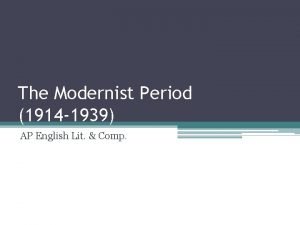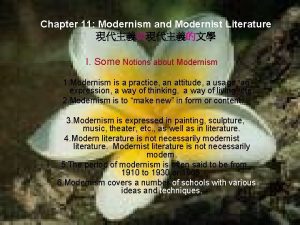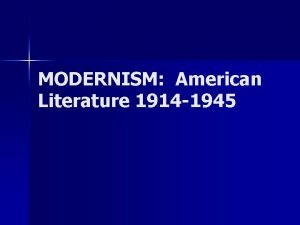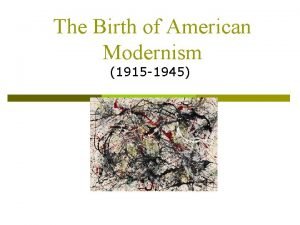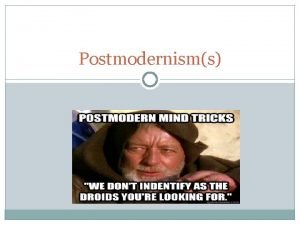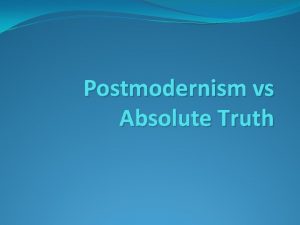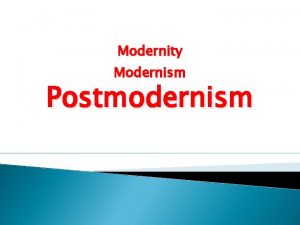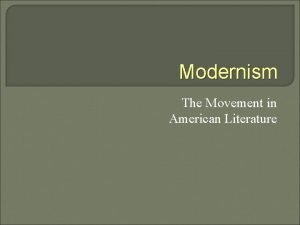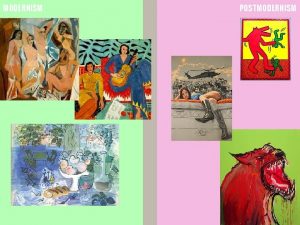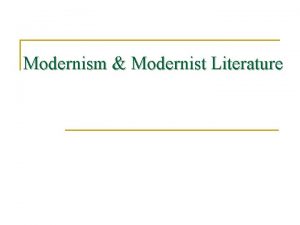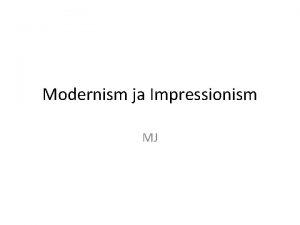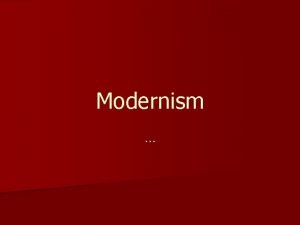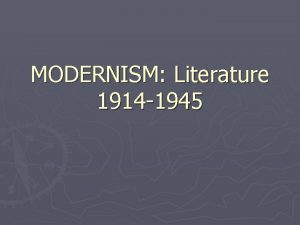Chapter 11 Modernism and Modernist Literature I Some









- Slides: 9

Chapter 11: Modernism and Modernist Literature 現代主義與現代主義的文學 I. Some Notions about Modernism 1. Modernism is a practice, an attitude, a usage, an expression, a way of thinking, a way of living, etc. 2. Modernism is to “make new” in form or content. 3. Modernism is expressed in painting, sculpture, music, theater, etc. , as well as in literature. 4. Modern literature is not necessarily modernist literature. Modernist literature is not necessarily modern. 5. The period of modernism is often said to be from 1910 to 1930 or 1965. 6. Modernism covers a number of schools with various ideas and techniques.

II. Characteristics of Modernism: • Formal/Stylistic Characteristics: • • Free indirect speech & free association Stream of consciousness & interior monologue Discontinuous narrative & multiple narrative points of view Quotation & wide use of classical allusions, etc. • Thematic Characteristics: • Life is viewed as incoherent, experience as fragmented, reality as a matter of perception. • Alienation & spiritual loneliness • Objection to traditional thoughts and moralities • Disillusionment and despair of the individual • Breakdown of social norms, etc.

III. Some Branches of Modernism: • • • Free verse Dadaism Stream of consciousness technique Anti-novel, anti-play, nouveau roman Imagism, symbolism Expressionism New humanism Existentialism Theater of the absurd, etc.

IV. Some Important Modernists: • Ireland: James Joyce, W. B. Yeats • England: Virginia Woolf, Dylan Thomas, D. H. • • Lawrence, E. M. Forster, Joseph Conrad, Katherine Mansfield, Samuel Beckett France: Marcel Proust (pioneer of 意識流) Italy: Luigi Pirandello (relativist) Bohemia: Franz Kafka (alienation) America: T. S. Eliot, Gertrude Stein, H. D. (Hilda Doolittle 意象派 Imagist), , Ezra Pound, William Faulkner, Ernest Hemingway, Katherine Anne Porter, F. Scott Fitzgerald, Robert Frost

V. Some Famous Modernist Works: • • • Ulysses by Joyce Mrs. Dalloway by Virginia Woolf Waiting for Godot by Beckett Remembrance of Things Past by Proust Six Characters in Search of an Author Metamorphosis by Kafka The Waste Land by T. S. Eliot The Sound and the Fury by Faulkner The Old Man and the Sea by Hemingway by Pirandello

VI. Stream-of-Consciousness Technique: • “It is a narrative mode that seeks to portray an individual’s point of view by giving the written equivalent of the character’s thought processes, either in a loose interior monologue, or in connection to his or her actions. ” • “Stream-of-consciousness writing is usually regarded as a special form of interior monologue and is characterized by associative leaps in syntax and punctuation that can make the prose difficult to follow. ” • “In stream of consciousness, the speaker’s thought processes are depicted as overheard in the mind (or addressed to oneself); it is primarily a fictional device. “ -- Wikipedia • In using the technique, the author focuses mainly on characterization, rather than on action or setting of the narrative. The story, however, can be reconstructed from the thought content.

VII. Some Works Written with the Stream-of-Consciousness Technique: • T. S. Eliot’s “The Love Song of J. Alfred Prufrock”: • “With its weariness, regret, embarrassment, longing, emasculation, sexual frustration, sense of decay, and awareness of mortality, Prufrock has become one of the most recognized voices in 20 th-century literature, and is the quintessential urban zeitgeist of the 20 th century. ” --Wikipedia • Proust’s Remembrance of Things Past (or, In Search of Lost Time): • “It is known for its length and the notion of involuntary memory, the most famous example being the episode of the madeleine. . Involuntary memory is triggered by sensory experiences such as sights, sounds and smells which conjure important memories for the narrator. ” It explores a lot of themes (snobbism, deceit, jealousy and suffering, etc. ). One of them is the nature of art. For Proust, “art can recapture the lost and thus save it from destruction, at least in our minds. ” --Wikipedia

VII. Some Works Written with the Stream-of-Consciousness Technique: • Joyce’s Ulysses: • It “chronicles the passage of Leopold Bloom through Dublin during an ordinary day, 16 June 1904. ” Leopold corresponds to Odysseus, Molly Bloom to Penelope, and Stephen Dedalus to Telemachus. It has 18 episodes. The book contains a number of pages without punctuation to show the stream of consciousness that goes with the words. • Virginia Woolf’s Mrs. Dalloway: • • It details a day in the life of Clarissa Dalloway in post-World War I England. The story is about Clarissa’s preparations for a party of which she is to be hostess. It travels forwards and back in time and in and out of the characters’ minds to construct an image of Clarissa’s life and of the interwar social structure. Woolf blurs the distinction between direct and indirect speech throughout the novel. The novel has such themes as mental illness, existentialism, feminism, and homosexuality. --Wikipedia

西洋文學概論 Introduction to Western Literature • • • Vol. II The Romantic Movement and Romantic Literature Realism and Naturalism in Literature Symbolism in Literature Modernism and Modernist Literature Existentialism and Literature Postmodern Literature 董崇選 中山醫學大學應用外語系教授 「懂更懂學習英文網站」負責人 http//: dgdel. nchu. edu. tw
